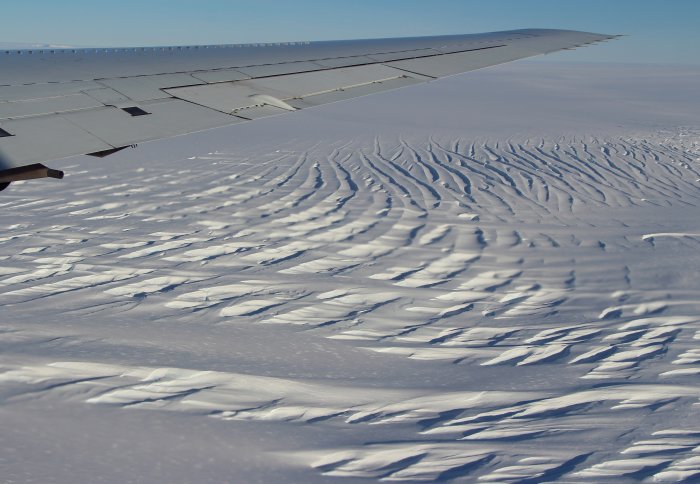Cause of long, potentially damaging channels on Antarctic ice shelves found

Crevassing on the Foundation Ice Stream
Large rock hills deep below glaciers can cause huge channels on the ice surface – even if the hills are buried under two kilometres of ice.
Glaciers in Antarctica are remote and difficult to study, which means much about their behaviour is unknown. These knowledge gaps mean scientists cannot be sure how they will respond to climate change.
However, with new technology researchers are able to study them in greater detail than ever before, even looking through kilometres-thick glaciers to view processes occurring at their bases.
This finding will help us pinpoint potential regions of Antarctica that may be of enhanced risk of change because of ice shelf channelling. Professor Martin Siegert
The team, including researchers from universities in the UK and the US, used ice-penetrating radar mounted on planes to peer through the glacier and work out what is happening at its base.
In a study published today in Nature Communications, researchers led by Imperial College London have connected a huge 130-km-long channel (the distance between London and Birmingham) on the surface of an Antarctic floating ice shelf to the landscape two kilometres below the ice sheet upstream.
The channel, and associated features on the ice surface, are thought to be a point of instability on the ice shelf. If the surface ice melts, water will preferentially run down these features, carving out a deeper channel and creating further weaknesses.
Identifying instabilities
Ice-shelf surface channels are seen across Antarctica, so the process uncovered in the research is likely to be commonplace. Now the cause has been identified, researchers can investigate similar channels for signs of instability elsewhere in Antarctica, especially in regions known to be vulnerable to change.
Project lead Professor Martin Siegert, from the Grantham Institute – Climate Change and the Environment at Imperial, said: “This finding will help us pinpoint potential regions of Antarctica that may be of enhanced risk of change because of ice shelf channelling. It also reminds us that we can't ignore subsurface processes – even if they are below two kilometres of ice in some of the most remote places on Earth.”
He added: “Surface melting on Antarctic ice shelves has been noticed in the last few years, and further warming of atmospheric conditions would lead to increased levels – adding to the need to restrain global warming to 1.5C above pre-industrial levels.”
Holding back the ice
The region the team studied – centered on the Foundation Ice Stream – is one of the poorest known parts of Antarctica, near the edge of the ‘grounded’ ice sheet, resting on land rather than water. The grounded ice sheet feeds ice into the ocean, and so contributes to sea level change.
Holding the ice sheet back are the floating ice shelves, which provide a ‘back force’ to reduce the speed of the grounded ice. Weakness in the floating ice shelf can therefore lead to accelerated flow of the grounded ice, and sea level rise.

The Foundation Ice Stream is also the type of glacier that can have water at its base, flowing between the bottom of the glacier and the underlying rock. The team found that when the base of the glacier encountered a large solitary hill at the same point it starts to float,a gap emerged under the ice downstream of the hill.
This gap was filled by water from around the base of the glacier, which carved a gouge upwards into the ice. This gouge was 800 metres high in some places, and led to the extensive channel seen on the surface of the ice.
-
‘Hard rock landforms generate 130 km ice shelf channels through water focusing in basal corrugations’ by Hafeez Jeofry, Neil Ross, Anne Le Brocq, Alastair Graham, Jilu Li, Prasad Gogineni, Mathieu Morlighem, Thomas Jordan & Martin J. Siegert is published in Nature Communications. Read the Open Access version.
Article text (excluding photos or graphics) © Imperial College London.
Photos and graphics subject to third party copyright used with permission or © Imperial College London.
Reporter
Hayley Dunning
Communications Division